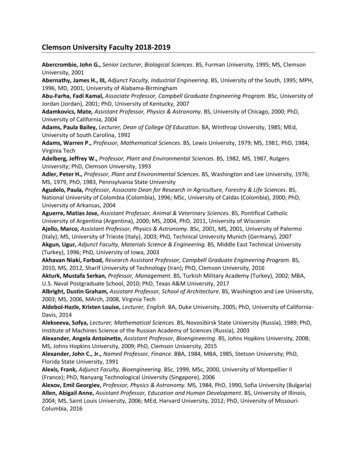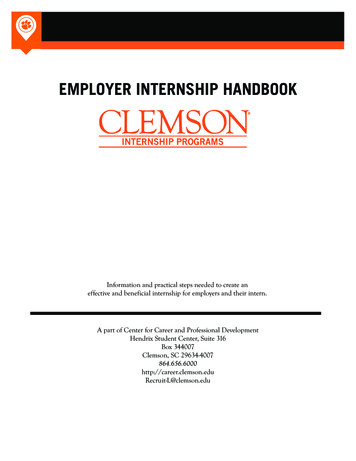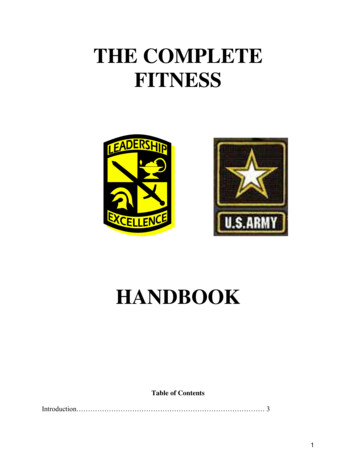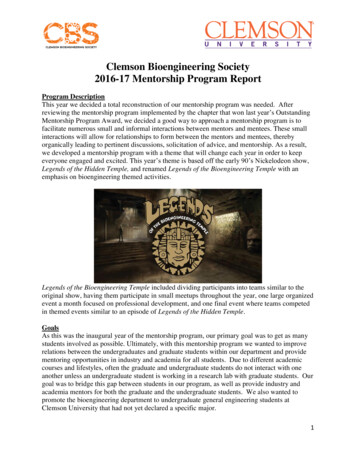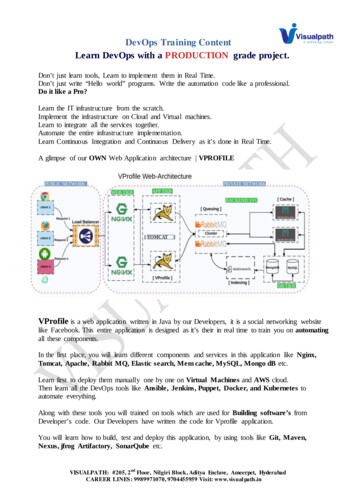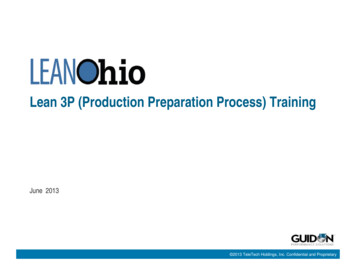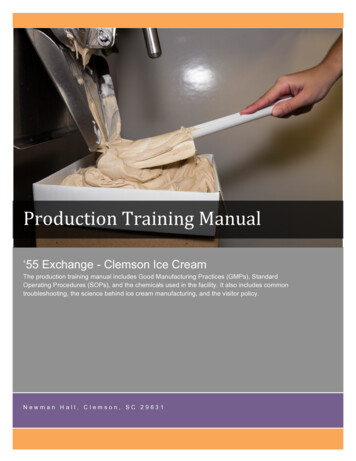
Transcription
Production Training Manual‘55 Exchange - Clemson Ice CreamThe production training manual includes Good Manufacturing Practices (GMPs), StandardOperating Procedures (SOPs), and the chemicals used in the facility. It also includes commontroubleshooting, the science behind ice cream manufacturing, and the visitor policy.Newman Hall, Clemson, SC 29631
Product: Clemson Ice CreamPlant Name: Clemson’s ’55 Exchange CreameryIssue Date: 8/19/2016Address: Creamery, Newman Hall, Clemson, SC 29634Supersedes: 7/20/2016Clemson Ice CreamProducing the World’s Best Ice CreamWelcome to the team! You have been selected to carry on the tradition of Clemson Ice Cream atClemson’s ‘55 Exchange. In the following pages you will be guided in the best ways to produce(standard operating procedures) and handle ice cream (good manufacturing practices). Thismanual explains the basic techniques of freezing ice cream without going into how each specificflavor is made. We hope you enjoy working in the creamery. You have a very important job incarrying on the long-standing tradition of Clemson Ice Cream. The World’s Best Ice Creammade by the World’s Best Students!Contact listNamePhone numberDr. McGregor864-650-0817Kinsey MacDonald803-807-6835Sara Stancil Cothran864-508-0875Food Science Office864-656-3397PRODUCTION TRAINING MANUAL 2
Product: Clemson Ice CreamPlant Name: Clemson’s ’55 Exchange CreameryIssue Date: 8/19/2016Address: Creamery, Newman Hall, Clemson, SC 29634Supersedes: 7/20/2016TABLE OF CONTENTSTraining Program 4Guiding Principles .5Good Manufacturing Practices 6Standard Operating Procedures . 10Troubleshooting .16The Science of Ice Cream .17Chemical List . 19Visitor Policy .20Glossary .21Sample Forms 23PRODUCTION TRAINING MANUAL 3
Product: Clemson Ice CreamPlant Name: Clemson’s ’55 Exchange CreameryIssue Date: 8/19/2016Address: Creamery, Newman Hall, Clemson, SC 29634Supersedes: 7/20/2016TRAINING PROGRAMWho: The production manager trains all employees who work in ice cream production. The faculty advisor will be in production a minimum of once a semester, within the firstmonth.When: At the start of employment of production staff Annually for refresher training As changes are made to personnel practices/procedures As needed for retraining if employee puts food safety at risk (monitored through thepersonal practice form)What: Before the first day of work, employees will be required to read the production-trainingmanual. Then the production manager will train verbally and by hands-on demonstrationduring an ice cream production.How: Employees read the SOP program before training occurs and will be required to read andunderstand GMP requirements Employees may be verbally assessed for understanding of GMP requirements. Assess the trainee’s understanding by observing as he/she performs the duties.Monitoring TrainingThe trainer and the trainee must sign the training record after each training session is complete. All initial training and retraining must be recorded and verified.PRODUCTION TRAINING MANUAL 4
Product: Clemson Ice CreamPlant Name: Clemson’s ’55 Exchange CreameryIssue Date: 8/19/2016Address: Creamery, Newman Hall, Clemson, SC 29634Supersedes: 7/20/2016GUIDING PRINCIPLES Safety is the most important!o The safety of our staff is very important to us. Training of employees is crucial totheir safety.o We are also concerned with food safety. Following this guide will help keep thefood safe for our customers! Faculty Involvemento Faculty advisor will oversee production to ensure proper production and enhancelearning at least once a semester Learning Environmento Students will understand technical information that relates to ice creamproduction (i.e. overrun, compressor, etc.) while gaining hands-on experience.PRODUCTION TRAINING MANUAL 5
Product: Clemson Ice CreamPlant Name: Clemson’s ’55 Exchange CreameryIssue Date: 8/19/2016Address: Creamery, Newman Hall, Clemson, SC 29634Supersedes: 7/20/2016GOOD MANUFACTURING PRACTICESPersonal Hygiene PracticesA high standard of personal cleanliness is required for all personnel in this facility. Properhygiene can prevent contamination of ingredients, products or packaging. All employees mustfollow the rules for working in food handling areas.Employees at ’55 Exchange must follow these practices: Come to work clean. Keep fingernails trimmed and clean. Do not wear fingernail polish, false eyelashes or fingernails, badges, pins, etc. Avoid touching body parts, including hair, nose, arms, eyes, etc. If hands becomecontaminated, wash them. Turn away from food, ingredients, packaging materials and food contact surfaces, whencoughing or sneezing. Use the crook of your elbow or shoulder. Then wash hands/exposed arms. Do not eat, drink, smoke, chew gum or tobacco, or spit in any food handling areas. Allfood should be consumed outside of the production facility. Do not taste test in production or storage areas. Products can be taste tested outside of theproduction space or when it reaches the store. Do not wear loose items in breast pockets or on shirt collars [or smocks, overalls, labcoats, etc.] This includes pens, thermometers, etc. Placed all personal items (phone, keys, etc.) in the proper location. This location iscurrently in the back storage room. Do not store waste on or near food, ingredients, packaging materials or food contactsurfaces. Throw out any ingredient, packaging, or product that falls on the floor. Do not store ingredients or packaging materials directly on the floor. Do not wear any exposed jewelry, including watches. The only exception is a medic alertbracelet or necklace, if it’s covered or tucked inside clothing. Do not bring glass into food processing and storage areas.PRODUCTION TRAINING MANUAL 6
Product: Clemson Ice CreamPlant Name: Clemson’s ’55 Exchange CreameryIssue Date: 8/19/2016Address: Creamery, Newman Hall, Clemson, SC 29634Supersedes: 7/20/2016Hand Washing PracticesProper hand washing is critical in preventing the spread of bacteria. It greatly reduces thechances of contaminating food and food contact surfaces. All employees must wash their handsthoroughly and frequently.Hand Washing ProcedureWash your hands at the designated automatic hand washing station. For proper hand washing,follow these steps: Pre-rinse hands with warm clean water. Apply soap. Rub hands, fingers, nails and wrists to form a lather for a minimum of 20 seconds. Rinse hands with warm clean water. Dry hands using Xcelerator Hand DryerNote: A poster with hand washing instructions is located by the hand-washing sink.Hand Washing FrequencyAll employees must wash their hands: When starting or returning to work After using the bathroom After handling food allergens [lemon custard (egg), pecans (tree nuts), Oreo’s, vanillawafers and cookie dough (wheat), etc.] After touching hair, ears, nose, mouth, etc. After sneezing and/or coughing After handling garbage or waste bins After lunch and breaks Every time hands become contaminatedPRODUCTION TRAINING MANUAL 7
Product: Clemson Ice CreamPlant Name: Clemson’s ’55 Exchange CreameryIssue Date: 8/19/2016Address: Creamery, Newman Hall, Clemson, SC 29634Supersedes: 7/20/2016Clothing, Footwear, HeadwearEmployees must wear clean clothing that is designed for the operation to prevent contaminationof food ingredients, packaging and food contact surfaces (ex: aprons, rain boots, hair net).All employees must follow these rules: Come to work in clean clothing. Put on rain boots, apron, and hair net before starting your shift. Keep designated work clothing clean and in good repair (ex: no holes, loose threads,loose buttons, etc.) Wear clean shoes/boots inside the facility. You must put on designated work boots beforestarting a shift and take them off after the shift. If leaving the production area, be sure toremove the work boots. Wear suitable hair covering (hair net and beard net when applicable) to prevent hair fromdirectly or indirectly touching food, equipment, utensils, etc. Do not wear designated work clothing in bathrooms, lunchrooms or outside theproduction facility. Change designated work clothing if it gets soiled during a shift. If boots become soiled, rinse with hot water and apply soap using red brush. If apronbecomes soiled, place in orange laundry bag. Aprons are worn once before washing and drying at a designated student’s home. Store street shoes in the back storage room.Note: All visitors to our facility, including suppliers and contractors, must wear a head covering(i.e. hat or hair net).Injuries and WoundsAll employees must follow these rules: Report all work related injuries to management immediately. When someone is injured or wounded, immediately apply first aid, as stated in theEmergency Procedure Handbook. Ensure anyone with an open cut or wound has it securely and hygienically covered ifworking with food, packaging or food contact surfaces (ex: waterproof bandage coveredwith a glove). Determine which food, ingredients, packaging materials and food contact surfaces werecontaminated as a result of the injury or wound. Ensure contaminated items are disposed of and food contact surfaces are cleaned andsanitized, using company sanitation procedures. Record the incident on the company’s incident report/corrective action form. Ensure any visitor with an exposed open cut or wound securely and hygienically covers itbefore entering the facility.PRODUCTION TRAINING MANUAL 8
Product: Clemson Ice CreamPlant Name: Clemson’s ’55 Exchange CreameryIssue Date: 8/19/2016Address: Creamery, Newman Hall, Clemson, SC 29634Supersedes: 7/20/2016Evidence of IllnessEmployees should not handle food or work when they are sick. All employees must report anysymptoms of illness or any diagnosed illness to the manager immediately.Symptoms of illness include, but not limited to: Diarrhea Vomiting Jaundice (yellowing of the skin and/or eyes) Sore throat with fever Infected cuts or wounds, or lesions containing pus on the hand, wrist, and exposed bodypart (such as boils and infected wounds, however small).Diagnosed illness includes, but not limited to: Norovirus Salmonella Typhi (typhoid fever) Shigella spp. Infection E. coli infection (Escherichia coli O157:H7 or other EHEC/STEC infection) Hepatitis ANote: Manager must report any of these illnesses to the Health Department.Although you may not have any symptoms or diagnosed illness, you may be in contact withsomeone who does. If you know that you are exposed to an illness, you must notify the managerwhen: You have an outbreak of Norovirus, typhoid fever, Shigella spp. Infection, E. coliinfection, or Hepatitis A. A household member has an outbreak of Norovirus, typhoid fever, Shigella spp.Infection, E. coli infection, or Hepatitis A. A household member attending or working in a setting with an outbreak of Norovirus,typhoid fever, Shigella spp. Infection, E. coli infection, or Hepatitis A.If you have any of the symptoms, diagnosed illness, or exposure to the listed illnesses, you maybe either excluded or restricted from work. If you are excluded from work, you are not allowedto come to work at all. If you are restricted from work, you are allowed to come to work, butyour duties may be limited (to non-food tasks).If you are excluded from work for having diarrhea and/or vomiting, you will not be able to returnto work until more than 24 hours have passed since your last symptoms of diarrhea and/orvomiting.If you are excluded from work for exhibiting symptoms of a sore throat with fever or for havingjaundice, Norovirus, Salmonella typhi, Shigella spp. Infection, E. coli infection, and/or HepatitisA, you will not be able to return to work until Health Department approval is granted.PRODUCTION TRAINING MANUAL 9
Product: Clemson Ice CreamPlant Name: Clemson’s ’55 Exchange CreameryIssue Date: 8/19/2016Address: Creamery, Newman Hall, Clemson, SC 29634Supersedes: 7/20/2016Monitoring Personnel PracticesPersonnel practices are monitored every production by the production manager, who mustdocument the process on the personnel practices checklist. The checklist and/or corrective actionmust be reviewed and verified within 1 week.STANDARD OPERATING PROCEDURESClean and sanitize the machine and utensils. Plug the sink with the sink stopper and turn the water on to hot (140oF). Pour in 1 oz. 2171 General Cleaner into the sink. Fill the sink halfway up (3 gallons) with hot water, and then turn the water off. Put all utensils and machine parts in the sink of soapy water. As they sit in the water, measure out 23 mL of Dibac Sodium Hypochlorite sanitizerusing the 25 mL graduated cylinder. Get a 4-gallon metal bucket, and add cold water while pouring in the sanitizer. Fill thebucket up ¾ of the way, and then turn off the water. This will be one of your sanitizerbuckets. With another 4-gallon metal bucket, add in 2171 general cleaner and hot water. Use thisbucket and brush to clean the inside of the machine, the top and sides of the machine, andthe table. Rinse using the hose under the sink. Squeegee the table top to dry. Clean the utensils, machine parts, and black mats, using the brushes (white bristlebrushes) that are in the sink of soapy water. Rinse everything down and place the utensils, machined parts, and mat in the sanitizerbucket for at least 30 seconds. This is to reduce the microbial load by 99%.PRODUCTION TRAINING MANUAL 10
Product: Clemson Ice CreamPlant Name: Clemson’s ’55 Exchange CreameryIssue Date: 8/19/2016Address: Creamery, Newman Hall, Clemson, SC 29634Supersedes: 7/20/2016Machine DiagramDasher BearingCenter ShaftDasherCover GasketBladesO-RingsWing NutsDasher BladeSpringsAssemble the batch freezer. Remove the mat from the sanitizer and place it in the middle of the table. Remove the machine parts and utensils from the sanitizer bucket and place them on themat on the table. Put the “O” rings on the center shaft Apply CIP (Clean in Place) lubrication to the center shaft and “O” rings, and wipe offany excess lube. Place it into the back of the barrel. Turn it to make sure it has locked inplace. Place the springs on the dasher, followed by the blades. The curved end of the bladesshould be in the back of the machine. Carefully place the dasher into the barrel, locking it in place with the center shaft. Apply CIP lube to the cover gasket, dasher bearing, and yoke bearings. Place the cover gasket around the opening of the barrel. Put the dasher bearing on the end of the dasher, making sure the silver knob fits in thegrove on the door before closing. Close the door to the freezer and place the studs on the yoke bearings and tighten them asmuch as possible by hand. Then, further tighten it further by lightly tapping each yokebearings once with the mallet. Turn on the compressor water hose that is located behind the machine. Now you can pull the switch that powers the machine, located above the table.Completely remove the lock and place it in a safe spot (on the box folding table) toensure that the power can be turned off easily in an emergency.PRODUCTION TRAINING MANUAL 11
Product: Clemson Ice CreamPlant Name: Clemson’s ’55 Exchange CreameryIssue Date: 8/19/2016Address: Creamery, Newman Hall, Clemson, SC 29634Supersedes: 7/20/2016Sanitizing assembled freezer. Pour the bucket of sanitizer into the batch freezer. Make sure that the gate door isclosed before pouring. Run the dasher on low speed, turning on and off for at leastTWO minutes. For the last 20 seconds, turn on the compressor switch to allow the barrelto pre-chill. Then empty out the sanitizer into a waste bucket.Monitoring Sanitation for Set-Up After sanitation is complete, equipment and parts must be inspected again for cleanlinessand damage and then reassembled using the previous instructions. Sanitation and inspection completion must be recorded on the Daily Sanitation Record.Adding the ingredients. Before adding ingredients, and depending on the day’s production, check the list of icecream recipes, which is located in the white binder next to the production list of the day.It will tell you which ingredients to use, and how much to use, for each ice cream flavor. Ingredients and ice cream mix are located in the walk-in cooler and freezer and should bemoved, as needed, to the creamery with the insulated cart. Mix is unboxed in the creamery. Shake the mix jug and then dunk into the 200-ppmsanitizer bucket for a minimum of 30 seconds. Remove the lids of the mix by pulling the tamper evident tab making sure to keep the lidand tamper evident tab attached. Pour all five gallons of mix and the needed flavorings into the batch freezer. Push out the air of the milk gallons and cap them and throw in the trash can. Recappingthe gallons allows us to make sure all lids and tamper evident tabs are accounted for anddid not end up in the ice cream.Trash and waste disposal Milk jugs are thrown in unlined trashcan and the trash is taken out as needed throughoutthe day to the dumpster beside Newman Hall. No designated work clothing can be wornwhen taking out the trash. Cardboard boxes are disassembled and placed next to box-making station. At the end ofproduction, all of the cardboard is then recycled in bin behind Newman Hall. Waste containers must be emptied and cleaned daily by Production Staff.PRODUCTION TRAINING MANUAL 12
Product: Clemson Ice CreamPlant Name: Clemson’s ’55 Exchange CreameryIssue Date: 8/19/2016Address: Creamery, Newman Hall, Clemson, SC 29634Supersedes: 7/20/2016Start the freezing process. Make sure the compressor water hose behind the machine is turned on. Next turn the dasher on to low (super premium ice cream setting) and turn thecompressor on (flip the right switch up). WARNING! Never leave the compressor on while the dasher is turned off -- it willfreeze the dasher in place! Put the lid on top of the cover. At 6 minutes, manually increase the speed of the machine to 200 RPM for the remainingtime. Each run should last approximately 8-9 minutes.Add other ingredients. At the required time and depending on the flavor (look in the recipe book for these exactinstructions), and add the correct amount of fruits, nuts, or other ingredients to the batchfreezer. If needed, slow the dasher to allow all of the ingredients to incorporate. Once all the ingredients are in, turn the dasher back to the original speed (165 RPM forsuper premium).Remove the finished product. After the timer has reached 8-9 minutes, the ice cream should be ready to pull. Before pulling, turn off the compressor and wait 30 seconds before pulling. Place an ice cream box on the shelf, right under the lip. Start by pulling on low speed andonly move to high (234 RPM) when the ice cream is coming out slowly. Turning it onhigh will help to get the rest of the ice cream to come out. Open the gate door and slowly let the ice cream flow into the box with a thickconsistency. If the ice cream is not firm, close the gate, turn the compressor back on andwait for a few minutes and proceed again. Continue to pull the ice cream until no more comes out. You will fill approximately 4boxes. Place the filled boxes in the -40 degrees F freezer for hardening. Each box should havethe production code date, which is the mix code date followed by the date (MM/DD/YY)you are doing production, as well as the name of the flavor on the side and top of the box. Example Code: 07516071916 where 07516 is the mix code and 071916 is the datePRODUCTION TRAINING MANUAL 13
Product: Clemson Ice CreamPlant Name: Clemson’s ’55 Exchange CreameryIssue Date: 8/19/2016Address: Creamery, Newman Hall, Clemson, SC 29634Supersedes: 7/20/2016Rinse between runs (if noted on the production sheet) After the ice cream is finished being pulled, fill the freezer with water and run the dasheron low speed, turning on and off for a couple of minutes, and then empty the water outinto the 5-gallon waste bucket. This may have to be repeated depending on the flavor justmade and the flavor that comes next. On the last run of water, turn the compressor on for20 seconds to allow the barrel to re-chill. Some flavors are fine to have carryover fromthe previous batch (for example, chocolate to dark chocolate chip) but others (forexample, lemon to mint chocolate chip) need a rinse in between.Disassembly After the last batch is completed, turn off the dasher and compressor. Fill the freezer with water and run the dasher on low speed, turning on and off for acouple of minutes, and then empty the water out into the 5-gallon waste bucket. Repeatseveral times until the water comes out of the machine fairly clear. Turn off the power switch (from the source) and lock. Also be sure to turn off thecompressor water hose behind the machine. Disassemble the freezer and clean all parts in the sink and scrub the machine using thewhite bristle brush (paying extra attention to removing all soil, especially in the very backof the machine). Rinse the cleaning solution off. Do not sanitize the machine or machineparts. Keep the machine open to dry overnight. Allow pieces of the ice cream machine to dry by leaving the pieces on the cleaned table. Do not reassemble the batch freezer; the parts will be cleaned and sanitized before nextuse.Clean-up After the initial wipe down of the gross build-up using a reusable cleaning cloth, prerinse the surfaces of tables and equipment using warm, clean water at low pressure (makesure to minimize spray by controlling the pressure and direction to prevent crosscontamination). Scrub the table top, and the freezer and refrigerator doors with a concentrated soap (2171General Cleaner) solution and a yellow bristle brush. Rinse with warm water. Squeegee the table top and the top of the machine and place the black mats back down. Squeegee the floors, including around the machine and under the sinks and freezers. Return all ingredients to where they were originally found. Wash any remaining equipment and utensils. Sweep the walk-in freezer and cooler area and then mop the area. Rinse the insulated cart. Leave the insulated cart open to dry. Turn off the water hose under the hand wash sink.PRODUCTION TRAINING MANUAL 14
Product: Clemson Ice CreamPlant Name: Clemson’s ’55 Exchange CreameryIssue Date: 8/19/2016Address: Creamery, Newman Hall, Clemson, SC 29634Supersedes: 7/20/2016 Dump out all buckets and clean them inside and out. Place them in the sink or the lowershelf of the table, off the floor. Push table and ladder in front of both -40F freezers, so the doors don’t pop open duringthe night. Tape up boxes and take out the trash. Rinse/wash the trashcan. Squeegee any remaining water from the floor. Turn off the lights and lock the door.Monitoring Sanitation for Set-Up After sanitation is complete, equipment and parts must be inspected again for cleanlinessand damage.Sanitation and inspection completion must be recorded on the Daily Sanitation Record.If sanitation is inadequate, it must be repeated.Other Standard Operating Procedures1. Keep containers well maintained (no cracks or leaks) and clean.2. The production manager must ensure areas such as storage areas and office are kept cleanand organized.3. Vehicles used to transport food products must be kept clean. This includes cleaning outthe carts at the end of production days by spraying it down with the hose. Crosscontamination of ingredients, food products, packaging materials and chemicals used insanitation or maintenance must be prevented during transportation by not transportingincompatible materials (for example, food and chemical sanitizers) at the same time. Onecart is strictly for production days and will be kept inside Newman Hall at all times. Onecart will be used for deliveries to the Hendrix Center (retail store). The carts will beclearly labeled in order to avoid confusion and unnecessary contamination.PRODUCTION TRAINING MANUAL 15
Product: Clemson Ice CreamPlant Name: Clemson’s ’55 Exchange CreameryIssue Date: 8/19/2016Address: Creamery, Newman Hall, Clemson, SC 29634Supersedes: 7/20/2016TROUBLESHOOTINGProblemIf the batch freezer isn’t freezing after 10minutesSolution If you drop something (i.e. a spatula) into thefreezer Check the compressor hose behind themachine to make sure water is comingout.If no water is coming out, turn on thewater hose behind the machine.If still nothing is happening, take frontright side panel off machine and pressgreen button. You should hear thefreezer turn on.Turn off the dasher.Turn off power switch (located abovetable).Open up machine and remove contents.Rinse, wash and sanitize (seeprocedures for details).Reassemble machine.Continue on with next scheduled run.If DHEC comes Call people starting at the top of the calllist.If you get a minor cut Get a Band-Aid from the First Aid kitand use a rubber or latex glove for theremainder of the production runs.If there is any blood, clean and sanitizethe area. If you are seriously injured Depending on the seriousness of theinjury either call people on call list orgo to Redfern.If it is an emergency, call 911.PRODUCTION TRAINING MANUAL 16
Product: Clemson Ice CreamPlant Name: Clemson’s ’55 Exchange CreameryIssue Date: 8/19/2016Address: Creamery, Newman Hall, Clemson, SC 29634Supersedes: 7/20/2016THE SCIENCE OF ICE CREAMIngredient Functionality (In Our Mix/Ice Cream) 1Mix Ingredients: Milk, Cream, Sugar, Nonfat Dry Milk, Whey, and Ranger Stabilizer Blend Milk and Creamo Milk and cream both add fat to the ice cream, which adds richness. It alsostabilizes the base mix and improves the density and smoothness of the texture. Italso increases the flavor of the ice cream. Sugar (100% Sucrose)o Sugar not only sweetens the ice cream, but also improves the texture and thebody. Sugar also reduces the freezing point; therefore the ice cream does notfreeze rock-solid and can be easily scooped! Nonfat Dry Milk and Wheyo Nonfat dry milk and whey both add more solids to the ice cream to help with thebody, texture, and smoothness of the ice cream. Having too few solids in the icecream can lead to larger ice crystal formation and the ice cream becoming icy. Ifthere are too many solids, the ice cream will have a sand-like texture, so it isimportant to have the right balance. Ranger Stabilizer Blend (Guar Gum, Mono & Diglycerides, Cellulose Gum, Polysorbate80, Carrageenan, Locust Bean Gum)o The stabilizer blend has both stabilizers and emulsifiers. The emulsifiers (Mono &Diglycerides, and Polysorbate 80) help to keep the mix combined. The stabilizers(Guar Gum, Cellulose Gum, Carrageenan, and Locust Bean Gum) improve thestructure, the texture (by reducing ice crystal formation), and reduce the meltdown speed of the ice cream (so the ice cream doesn’t drip as quickly). Airo The tiny air cells that are whipped into the ice cream during freezing areresponsible for the consistency of the ice cream and affect the texture and volume. Flavoring Ingredientso Flavoring ingredients are also more solids (similar to nonfat dry milk) and helpwith the body, texture, and smoothness of the ice cream. The flavors and otheringredients, such as cookies, increase the sweetness of the ice cream and createdifferent flavors. If you add too much of a sugary ingredient, it will reduce thefreezing point and the ice cream will be too -cream/PRODUCTION TRAINING MANUAL 17
Product: Clemson Ice CreamPlant Name: Clemson’s ’55 Exchange CreameryIssue Date: 8/19/2016Address: Creamery, Newman Hall, Clemson, SC 29634Supersedes: 7/20/2016Ice Crystal Formation2Ice crystals are formed when the water content in the base freeze. The ice crystals give the icecream solidity and body, as well as determining how fine or grainy the ice cream is. If large icecrystals form, the ice cream will taste icy and grainy. Therefore, we want small ice crystals,which will produce a finer and smoother texture. Freezing (in the barrel of the machine)- the churning motion of the machine allows theice cream to freeze quickly and uniformly, producing small ice crystals. When the icecream begins to freeze, a thin layer on the wall of the barrel freezes with rapid nucleation,which is the formation of many small ice crystals. The more small ice crystals, the lessroom for large ice crystals to form. The ice cream should be pulled (removed) from themachine when the temperature is about 23oF. Hardening- Only about 50% of the water in the ice cream is frozen after the freezing step.In order to freeze the rest of the water quickly for a smooth texture, the ice cream isplaced in the -40oF freezer. If the ice cream is not hardened quick enough, the water willbind to the small ice crystals and begin to form larger, coarse ice crystals when frozen.Therefore it is necessary to place the ice cream in the -40oF freezer as soon as the box isfilled.Slow Freezing Large Ice Crystals (bad)Quick Freezing Small Ice Crystals (good)OverrunThe overrun of ice cream refers to the amount of air that is incorporated into the mixture whenfrozen. To calculate overrun, use the following formula:% 𝑜𝑣𝑒𝑟𝑟𝑢𝑛 𝐹𝑖𝑛𝑎𝑙 𝑉𝑜𝑙𝑢𝑚𝑒 𝐼𝑛𝑖𝑡𝑖𝑎𝑙 𝑉𝑜𝑙𝑢𝑚𝑒𝑥 100𝐼𝑛𝑖𝑡𝑖𝑎𝑙 𝑉𝑜𝑙𝑢𝑚𝑒For example, if the volume of the ice cream doubled (final volume 10 gallons, initial volume 5 gallons), the overrun is equal to 100%. We produce our ice cream with an ideal overrun ofabout 80-90%. In order to check that our ice cream is meeting this overrun, the weight of a 3gallon box should be 13.5 lbs., and a 58 oz. tub should be 2.3 rystals/PRODUCTION TRAINING MANUAL 18
Product:
Product: Clemson Ice Cream Plant Name: Clemson’s ’55 Exchange Creamery Issue Date: 8/19/2016 Address: Creamery, Newman Hall, Clemson, SC 29634 Supersedes: 7/20/2016 PRODUCTION TRAINING MANUAL 2 Clemson Ice Cream Producing the World’s Best Ice Cream Welcome to the team! You have been s



